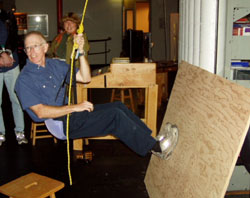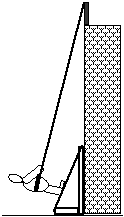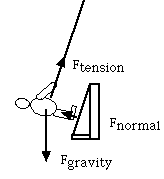Take a walk under Martian gravity

Walk under Mars gravity.

Feel Mars gravity.
Take a walk under Martian gravity

Walk under Mars gravity.

Feel Mars gravity.
Material
A high mounting point which can hold 1000 pounds (500 kg). A high swingset is good.(Or the anchor for a handrail 2 stories above the ground.)
If you don't have a swingset you can use:
4 x 4 foot square plywood. (1 m x 1 m)
2 x 4's to create a triangular support structure for the plywood.
Assembly
For Mars.
Attach the rope to the high strong anchor point. To achieve Martian gravity of 1/3 earth gravity the rope attachment point should be 3 times higher than the distance from the attachment wall to the waist of the person.
Make an inclined plane with the plywood and the 2 x 4's.
Make it slope in 1 foot for every 3 feet of
rise.
(If you use the 4 foot high board make it slope inward 16
inches.)
Place the inclined plane as close as possible to the wall beneath the anchor point.
To Do and Notice
Have one person put on the climbing harness. (I sometimes use a belay seat which is cheaper)
Attach the harness to the rope by tying it in or by using the carabiners.
The person stands on the inclined plane and jumps gently up and down or turns sideways and takes a step or two.
They will feel what it is like to walk under Martian gravity.
What's Going On?
When you walk on level ground the full force of the earth's gravity pulls you down into the ground.
If you hang from a rope that hangs straight down with your feet touching a vertical wall there will be no part of the downward pull of gravity tugging you toward the wall.
However if you are standing on an inclined plane with the rope holding a part of your weight up against gravity, then only a fraction of the earth's gravity force will be tugging you toward the inclined plane.
Math Root
If the inclined plane slopes inward one meter for every three meters of rise then the gravity force toward the surface of the incline is 1/3 of the force of gravity on earth, the actual gravity force on Mars.


The forces sum to zero. They form a right angle triangle.
The sum of the forces on you when you are at rest is zero. Since the tension force acts along the direction of the rope, and gravity acts downward there is another small force required to make the forces sum to zero, this is the force of the inclined plane on the person. It is called the normal force because it is normal to, or perpendicular to, the inclined plane.
The right angle triangle for the forces is similar to the right angle triangle of the inclined plane and the right angle triangle made by the rope and the legs of the person. Since the rope and the inclined plane both have a ratio of 1/3 between their sides, so does the force triangle. And so the force between the inclined plane and the person is 1/3 gravity.
Optional
You can also use a swingset to experience lunar gravity. Build the inclined plane as above and nail it into the ground beneath the swingset so that when the feet of the participant touch the inclined plane the ropes of the swingset are parallel to the surface of the inclined plane.
Math Root
The ratio of Fnormal/Fgravity is the cosine of the angle at the bottom of the inclined plane. When this angle is near 0 degrees the sin is near 1 and you fell full earth gravity. When the angle is near 90 degrees the sin is nearly zero and no force pulls you in toward the wall. For Martian gravity you want an angle whose sin is 1/3, about 68 degrees.
|
Scientific Explorations with Paul Doherty |
|
1 January 2004 |